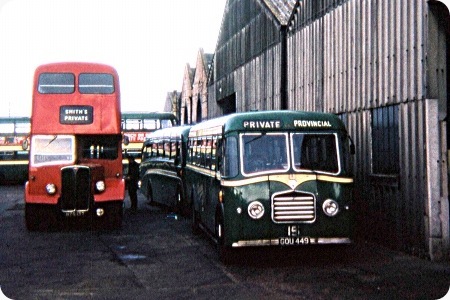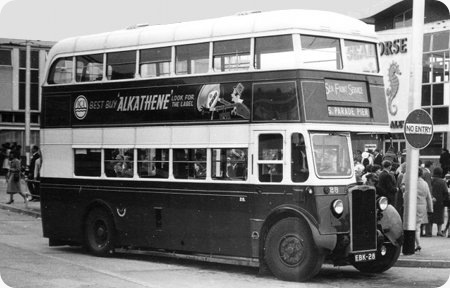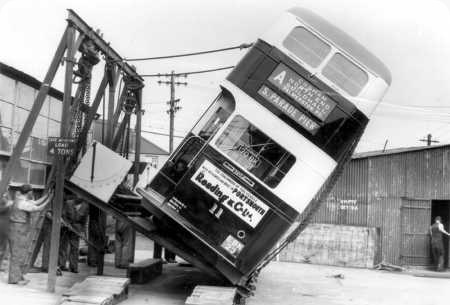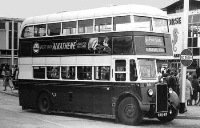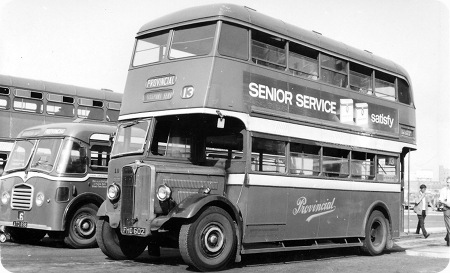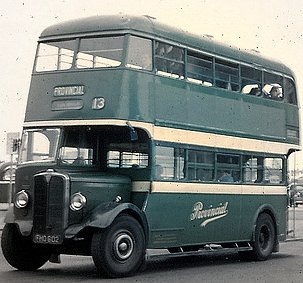Provincial – AEC Regal I – GOU 449 – 66
Provincial (Gosport & Fareham Omnibus Co)
1931
AEC Regal I
Reading FB35F
The Regent in the above shot was on the Crossley Omnibus Society Grand Southern tour and here it can be seen at the Provincial bus depot parked next to their number 66. Provincial had a tendency to get their monies worth out of the vehicles they owned and 66 was no exception. The vehicle was purchased from Timpsons of London in 1949 with the original registration of GN 7271, on arrival at Provincial it was immediately fitted with an AEC 7·7 litre diesel engine, rebodied with a Reading half canopy C32R body and reregistered as GOU 449. Ten years later it was rebodied again with the one in the shot above which was a Reading FB35F, it served a further 11 years at Provincial before being sold for scrap in 1970. This vehicle must be fairly high on the list of ‘longest serving vehicles’ at 39 years.
When David sent me this shot he said it was scanned from a very dark slide and he would understand if I did not use it, I think it would be a waste not to, especially a colour one and anyway David if you want to see a shot that should not be used click here.
Photograph contributed by David Beilby
Bus tickets issued by this operator can be viewed here.
———
09/02/11 – 05:48
It’s a bit like the old story of Paddy’s brush – or Caesar’s original penknife isn’t it? Nearly everything has been replaced, but there is still a clear historical trail that says it is still the original! I do not say this in any sense of criticism – I grew up in Barton’s territory, and beneath some of their shiny "new" vehicles (well, bodies anyway) you could discover mechanical antiques continuing to serve their original purpose perfectly satisfactorily.
Stephen Ford
———
01/07/11 – 06:15
Further photos of this vehicle with its original Reading coach body, plus what it might have looked like with Timpson can be found on the AEC Regal page at: //www.regent8.co.uk/ click on rotating arrow
Stephen Didymus
———
01/07/11 – 09:22
As Stephen rightly says at one time there were many fascinating "enigmas on wheels" giving splendid service for incredible lengths of time. Perhaps the most spectacular that I ever actually worked on was Samuel Ledgard’s magnificent Burlingham bodied AEC Regal – it was a Birmingham Corporation Regent 1 of 1930, but how many happy day trippers to the seaside could possibly have imagined that?? It had been rebuilt by Don Everall of Wolverhampton – a Corgi model of it exists, but with a Duple body instead of the correct Burlingham, and the registration FWJ 938 – should be FJW – but a lovely model nevertheless.
Chris Youhill
———
02/07/11 – 07:10
And here is The Maggot Wagon, Chris Y. //www.flickr.com/photos/21940361@N08/3883856963/
Chris Hebbron
———
02/07/11 – 07:12
Chris, the same could be said of the coach just visible behind 66. It is either 68 (OCG 444) or 69 (PCG 436)both of which were chassis that started life as City Of Oxford Regents in 1932, and acquired as such by Provincial in 1940. 68 was originally 22 (JO 5406), whilst 69 was rebuilt from a combination of 20/21 (JO 5404/5). Both were given Reading coach bodies in 1955/56 and survived until early 1969.
Stephen Didymus
———
02/07/11 – 12:07
Sorry for digressing slightly but FJW 938 seems doubly strange because it is pre-war, with a Regent (or Regal) II radiator and front wings and a Mk III bonnet!
Chris Barker
———
02/07/11 – 16:24
It’s a shame that virtually no information is immediately available about Reading and the other Portsmouth bodybuilder, Portsmouth Aviation.
Chris Hebbron
———
03/07/11 – 05:54
Thanks Chris H and Chris B – the bonnet and radiator are indeed fascinating features too – I wonder where they originated ?? – not from the shelves of a dealer in new parts I’ll be bound !! As the old darling is displaying "Otley" on the destination blind it has obviously recently carried "stage carriage" passengers in style and acoustic delight at absolutely no extra charge !!
Chris Youhill
———
03/07/11 – 20:40
Chris H: David Whitaker has written an excellent book on Readings the Portsmouth coachbuilders. Titled "Reading First & Last", it is available from the Provincial Society website. In addition to many bus photos of Provincial, Portsmouth, and Channel Island vehicles, there are also a considerable number of lorries, ambulances and ice cream vans.
Stephen Didymus
Quick links to the - Comments Page - Contact Page - Home Page
